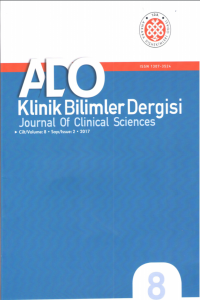Bruksizm Hakkında Bilgi Kaynağı Olarak YouTube™: Kesitsel İçerik Analizi
Bruksizm, Diş sıkma, Sosyal medya, Video
YouTube™ as an Information Resource on Bruxism: Cross-sectional Content Analysis
Bruxism, Clenching, Social media, Video,
___
- Manfredini D, Ahlberg J, Lobbezoo F. Bruxism definition: Past, present, and future–What should a prosthodontist know? J Prosthetic Dent 2022;128:905-12.
- Asutay F, Atalay Y, Asutay H, Acar AH. The evaluation of the clinical effects of botulinum toxin on nocturnal bruxism. Pain Res Manag 2017; 6264146.
- Christensen GJ. Destruction of human teeth. J Am Dent Assoc 1999;130:1229-30.
- Clark GT, Beemsterboer PL, Solberg WK, Rugh JD. Nocturnal electromyographic evaluation of myofascial pain dysfunction in patients undergoing occlusal splint therapy. J Am Dent Assoc 1979;99:607-11.
- Lavigne G, Kato T, Kolta A, Sessle B. Neurobiological mechanisms involved in sleep bruxism. Crit Rev Oral Biol Med 2003;14:30-46.
- Georgieva I. Trauma from occlusion—types, clinical signs and clinical significance. A review. Scripta Scientifica Medicinae Dentalis 2021;7:7-11.
- Peixoto KO, Resende CMBM, Almeida EO, Almeida-Leite CM, Conti PCR, Barbosa GAS, et al. Association of sleep quality and psychological aspects with reports of bruxism and TMD in Brazilian dentists during the COVID-19 pandemic. J Appl Oral Sci 2021;29: e20201089.
- Koyano K, Tsukiyama Y, Ichiki R, Kuwata T. Assessment of bruxism in the clinic. J Oral Rehabil 2008;35:495-508.
- Shim YJ, Lee MK, Kato T, Park HU, Heo K, Kim ST. Effects of botulinum toxin on jaw motor events during sleep in sleep bruxism patients: a polysomnographic evaluation. J Clin Sleep Med 2014;10:291-8.
- McMullan M. Patients using the Internet to obtain health information: how this affects the patient–health professional relationship. Patient Educ Couns 2006;63:24-8.
- Sahin SC, Dere KA. Quality of information in “masseter Botox” videos on YouTube: is it a sufficient guide for potential patients? Journal of Stomatology 2020;73:313-25.
- Öztürk G, Gümüş H. Çocuklarda Genel Anestezi Altında Uygulanan Diş Tedavileri ile İlgili YouTube™ Videolarının İçerik Analizi. Selçuk Dent J 2021;8:140-7.
- Yağcı F. Sabit protetik restorasyonlar için bilgi kaynaği olarak YouTube’un değerlendirilmesi. Sağlık Bilimleri Dergisi 2021;30:191-9.
- Çakır P, Eden E. Sosyal Medya Platformları Twitter, Instagram ve YouTube’daki Flor Paylaşımlarının Değerlendirilmesi: Kesitsel Araştırma. Turk Klin J Med 2022;28:61-71.
- Yagci F. Evaluation of YouTube as an information source for denture care. J Prosthet Dent 2021; S0022-3913(21)00364-4.
- ElKarmi R, Hassona Y, Taimeh D, Scully C. YouTube as a source for parents’ education on early childhood caries. Int J Paediatr Dent 2017;27:437-43.
- Hassona Y, Taimeh D, Marahleh A, Scully C. YouTube as a source of information on mouth (oral) cancer. Oral Dis 2016;22:202-8.
- Topsakal KG, Aksoy M, Akbulut AS. Çocuklara Uygulanan Ortodontik Tedavilere İlişkin Youtube Videolarının İçeriklerinin Değerlendirilmesi. NEU Dent J 2021;3:108-14.
- Asutay F, Atalay Y, Asutay H, Acar AH. The evaluation of the clinical effects of botulinum toxin on nocturnal bruxism. Pain Res Manag 2017;2017:6264146.
- Gaş S, Zincir ÖÖ, Bozkurt AP. Are YouTube videos useful for patients interested in botulinum toxin for bruxism? J Oral Maxillofac Surg 2019;77:1776-83.
- Ozsoy HE. Evaluation of YouTube videos about smile design using the DISCERN tool and Journal of the American Medical Association benchmarks. J Prosthet Dent 2021;125:151-4.
- Simsek H, Buyuk SK, Çetinkaya E. YouTube™ as a source of information on oral habits. J Indian Soc Pedod Prev Dent 2020;38:115-8.
- Lena Y, Dindaroğlu F. Lingual orthodontic treatment: a YouTube™ video analysis. Angle Orthod 2018;88:208-14.
- Yavuz MC, Buyuk SK, Genc E. Does YouTube™ offer high quality information? Evaluation of accelerated orthodontics videos. Ir J Med Sci (1971-). 2020;189:505-9.
- Pons-Fuster E, Ruiz Roca J, Tvarijonaviciute A, López-Jornet P. YouTube information about diabetes and oral healthcare. Odontology 2020;108:84-90.
- Ozdede M, Peker I. Analysis of dentistry YouTube videos related to COVID-19. Braz Dent J 2020;31:392-8.
- ISSN: 1307-3540
- Yayın Aralığı: Yılda 3 Sayı
- Başlangıç: 2006
- Yayıncı: Ankara Diş Hekimleri Odası
Hümeyra Özge YILANCI, Nursel AKKAYA, Gökçen AKÇİÇEK
Türkiye’deki Çocuk Diş Hekimlerinin Dental Radyografi Bilgi ve Tutumlarının Değerlendirilmesi
Esra Ceren TATLI, Elif GÜL AYDIN
Farklı Çok Katmanlı Monolitik Zirkonya Seramiklerin Yüzey Pürüzlülüğünün Değerlendirilmesi
Eda DÖĞÜŞCÜ, Özgül KARACAER, Merve BANKOĞLU GÜNGÖR
Ezgi SONKAYA, Güler Burcu SENİRKENTLİ, Yeşim TURAN, Zeliha BEK, Eda ÇAKMAK, Volkan CİFTCİ, Ebru TİRALİ
Otojen Dentin Greftleri ve Uygulamaları
Ahmet Berkant ÖZEN, İnci Rana KARACA
Bruksizm Hakkında Bilgi Kaynağı Olarak YouTube™: Kesitsel İçerik Analizi
Fehime ALKAN AYGÖR, Semiha EKRİKAYA
COVID-19 Pandemisinin Sağlık Çalışanlarının Mental Sağlığına Etkisi
Elif İNÖNÜ, Selvi CERAN, Pelin AYDIN, Mediha Nur NİŞANCI YILMAZ, Yasemin HOSGÖREN ALICI, Çaşıt Olgun ÇELİK
Zeynep Betül ARSLAN, Berrin ÇELİK
Çocuklarda Dental Anksiyetenin Değerlendirilmesinde Güncel Projektif Yöntemler
